Global Sanger Sequencing Market Size and Trends
Global sanger sequencing market is estimated to be valued at USD 3,729.8 Mn in 2025, and is expected to reach USD 12,173.2 Mn by 2032, exhibiting a compound annual growth rate (CAGR) of 18.4% from 2025 to 2032.
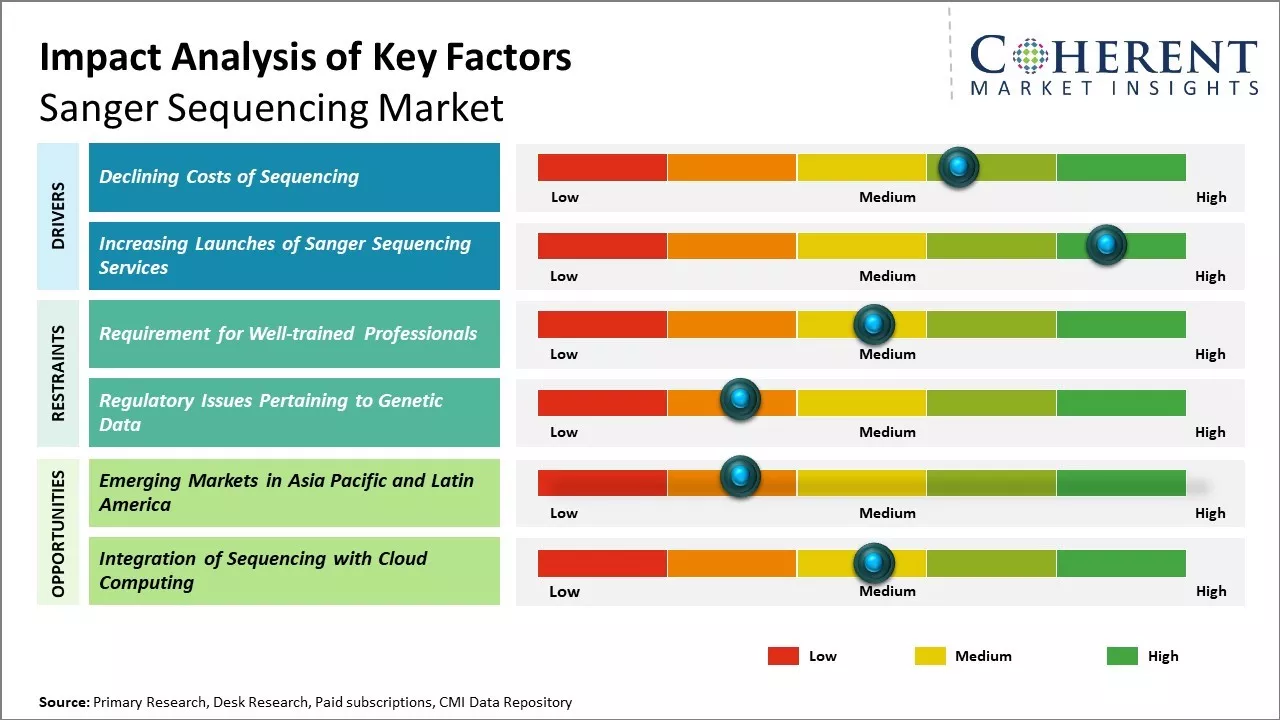
Discover market dynamics shaping the industry: Download Free Sample
Advancements in genome sequencing techniques and reduction in sequencing costs are some of the major factors driving the market growth. However, the market is expected to experience disruption from third generation sequencing platforms which provide higher throughput and longer read lengths at lower costs. Additionally, declining government funding for genome initiatives may hamper the market growth to some extent. Cumulatively, growing application areas of sequencing in clinical diagnosis, biomarkers, and precision medicine are anticipated to provide several opportunities for market expansion.
Market Driver – Declining Costs of Sequencing
The cost of sequencing a human genome has fallen dramatically in recent years. In 2001, sequencing a single genome cost nearly US$ 100 million as the Human Genome Project was just starting. However, the techniques used have advanced rapidly and become more automated. Sanger sequencing is now performed on a mass scale using robotics and computer algorithms to process samples. Through continuous innovation in sequencing technology and scale efficiencies, the cost of sequencing a human genome has dropped to only a few thousand dollars today. This reduction in sequencing costs has made it much more affordable for academic and medical research labs to conduct large-scale sequencing studies. The reduced costs have also enabled clinical genome sequencing for newborn screening, cancer profiling, and precision medicine applications. As sequencing costs decline further in the coming years with next-generation sequencing techniques becoming even more widespread, that expect to see genome sequencing used much more routinely in clinical practice and new applications emerging. This decline in sequencing costs is a primary driver fueling growth in the sanger sequencing market as it expands the potential applications and accessibility of sequencing technology.
Market Concentration and Competitive Landscape
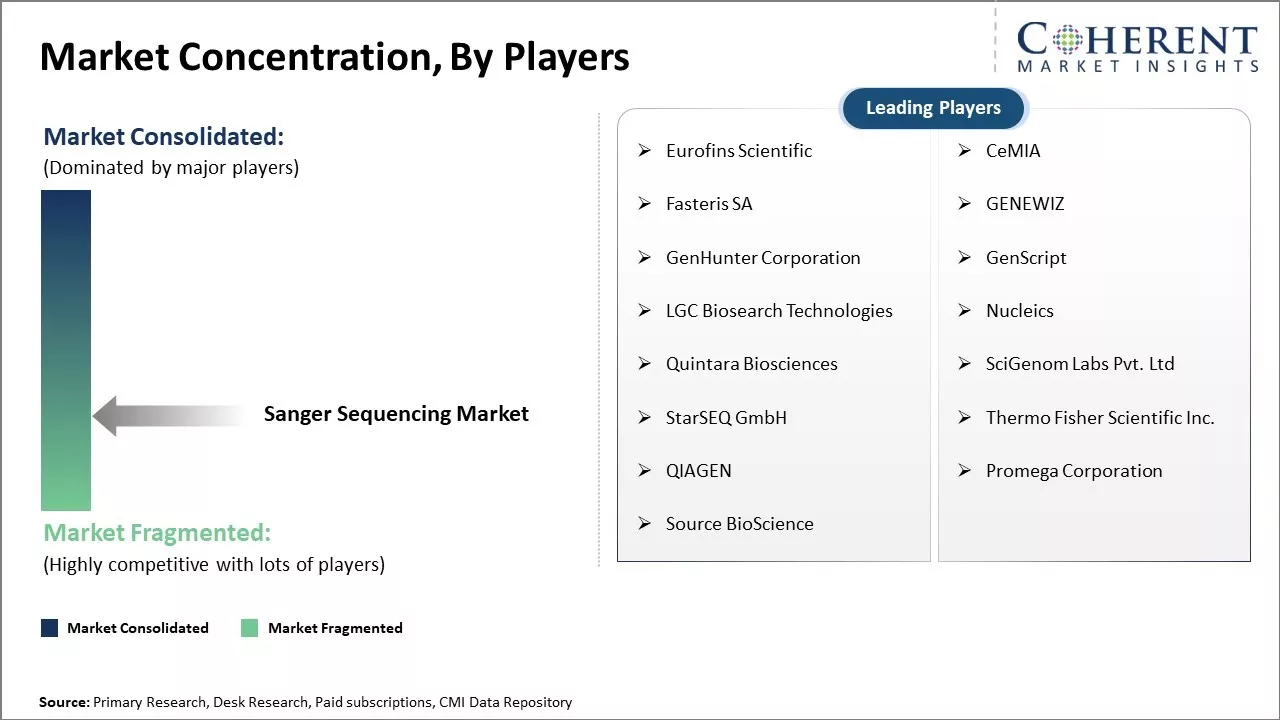
Get actionable strategies to beat competition: Download Free Sample
Increasing Launches of Sanger Sequencing ServicesIncreasing adoption of growth strategies, such as launch of sanger sequencing services, is expected to drive the growth of the market over the forecast period. For instance, in August, 2022, Source BioScience, a provider of genomic services, announced the launch of a sanger sequencing service in California, U.S. to support life science researchers with market-leading genomic services.
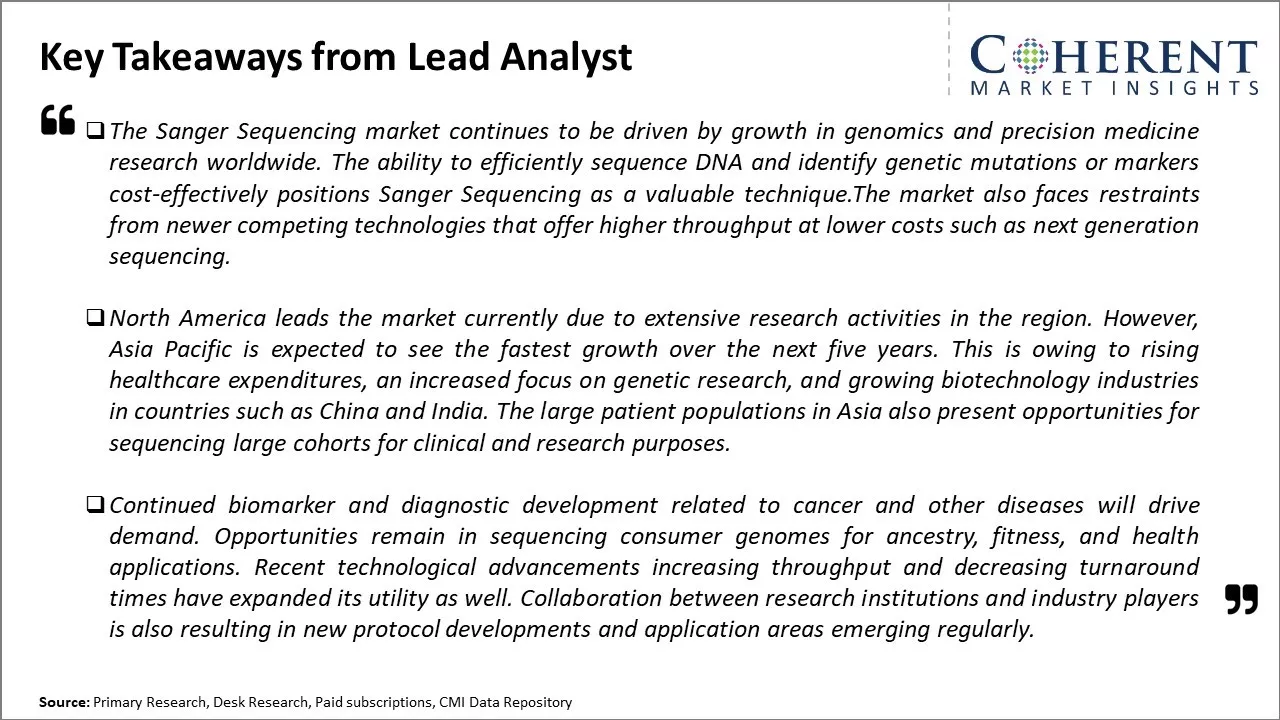
To learn more about this report, Download Free Sample
Market Challenges – Requirement for Well-trained ProfessionalsThe demand for well-trained professionals with expertise in genomics and DNA sequencing is putting immense pressure on the growth of the Sanger sequencing market. Sanger sequencing, also known as chain termination sequencing, is a technique used for DNA sequencing. Though it has been the predominant first-generation sequencing method for the past few decades, Sanger sequencing requires highly specialized training and skills to perform. With rapid advancements in newer high-throughput next-generation sequencing technologies, there is already a huge talent crunch for trained professionals with expertise in Sanger sequencing. Training newcomers to develop proficiency takes considerable time, effort, and expense given the specialized nature of the technique.
Market Opportunities – Emerging Markets in Asia Pacific and Latin America
Countries in these regions are experiencing rising healthcare investments and growing emphasis on genomic research. This provides a conducive environment for sequencing technologies to prosper. Governments and research institutions in Asia Pacific are undertaking several initiatives to enhance genomic capabilities. For instance, China's 13th Five Year Plan allocated funding to establish gene banks and biobanks across the country. Similarly, India's Biotechnology Industry Research Assistance Council has programs supporting large-scale genome sequencing projects. In Latin America, Mexico's National Institute of Genomic Medicine partners with international groups for population sequencing. Brazil too has announced plans to sequence 100,000 individuals to study genomic diversity.
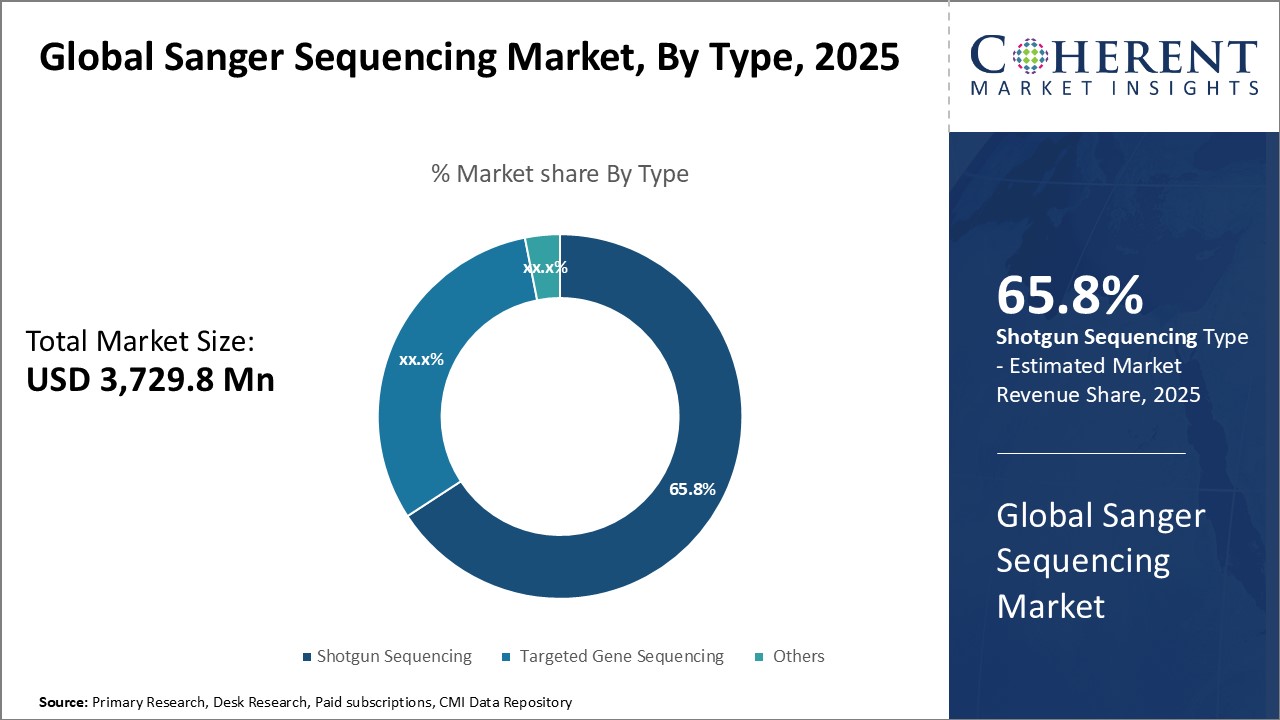
Discover high revenue pocket segments and roadmap to it: Download Free Sample
Insights, By Type: Rapid Technological AdvancementsType segment is sub-segmented into shotgun sequencing, targeted gene sequencing, and others. The shotgun sequencing segment is expected to hold 65.8% of the market share in 2025 owing to rapid technological advancements enhancing its capabilities. Shotgun sequencing involves randomly shearing DNA into smaller fragments that can be sequenced individually, allowing for massively parallel sequencing of entire genomes or transcripts. This approach has significantly accelerated since next-generation sequencing platforms enabled the reading of millions of DNA fragments simultaneously. In particular, continuous improvements to sequencing chemistries and instrumentation have boosted throughput while reducing costs. Sample preparation techniques have also evolved, minimizing hands-on time requirements.
Insights, By Application: Rising Diagnostic Application
Application segment is sub-segmented into diagnostics, personalized medicine, forensics, and others. The diagnostics segment is expected to hold 39.6% of the market share in 2025, due to the rising incorporation of sequencing into clinical diagnostics. Sanger sequencing plays a valuable role in a variety of diagnostic applications. It is commonly utilized for the confirmation of mutations identified through other methods due to its high accuracy. It also finds widespread use in newborn screening programs to detect genetic conditions. Sanger sequencing enables the evaluation of familial mutations associated with hereditary cancers, assisting oncology management.
Insights, By End-use: Increasing Research Initiatives
End-use segment is sub-segmented into government research institutes, diagnostic labs, pharmaceutical and biotechnology company, and others. The government research institutes segment is expected to hold 57.7% of the market share in 2025, due to extensive publicly-funded initiatives. Sanger sequencing remains a mainstay technology for genomic research activities due to its accuracy and scalability for analyzing targeted regions. Government agencies worldwide allocate large budgets for sequencing-based projects exploring genetic contributions to human health and disease. National sequencing centers employing Sanger methods to conduct research on human mutations, microbiome characterization, and others.
Regional Insights
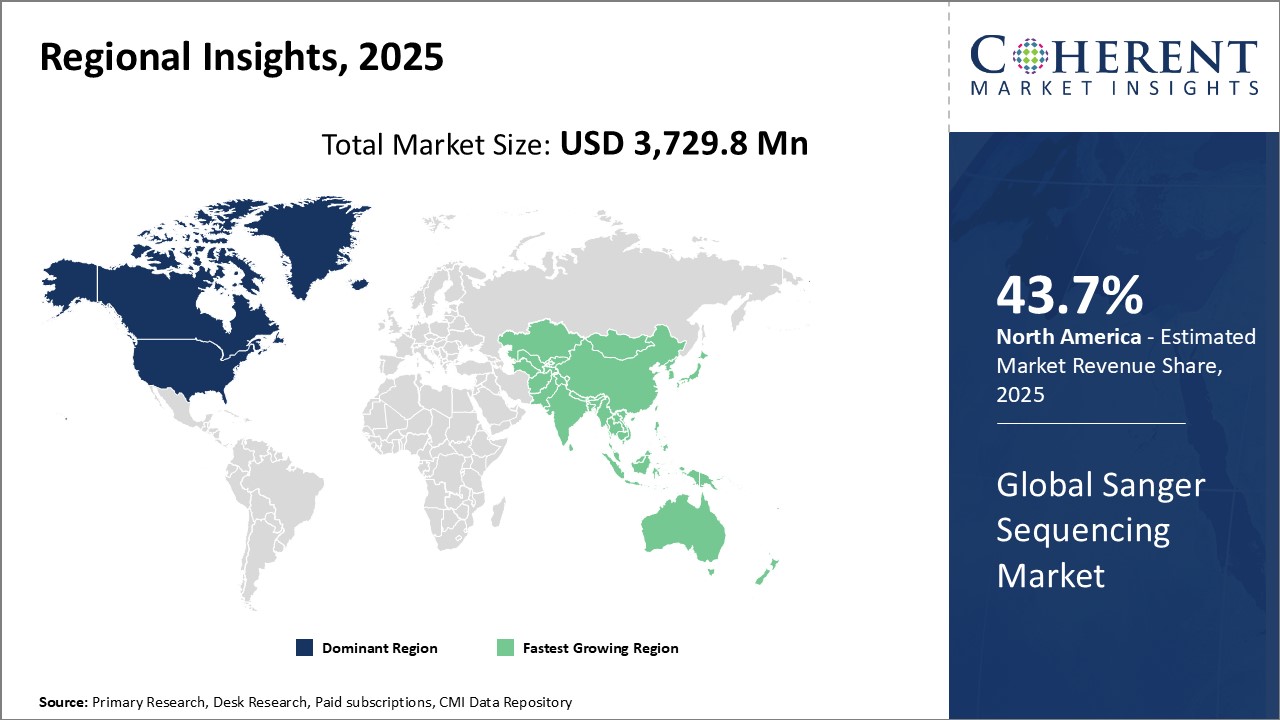
Need a Different Region or Segment? Download Free Sample
North America remains the dominant region in the global sanger sequencing market and is anticipated to hold 43.7% of the market share in 2025. Key market players operating in sanger sequencing such as Thermo Fisher Scientific Inc. and Illumina, Inc. have their headquarters in the U.S. These companies invest heavily in research and development. Several top universities and research institutions routinely employ Sanger sequencing for their research. This academic research further strengthens commercial applications and services in the country. The size and expertise of the biotechnology industry in the U.S. encourages continued adoption of Sanger sequencing tools and services in applications such as nucleic acid analysis, genetic testing, and forensics.
The Asia Pacific region has been witnessing impressive growth and is emerging as the fastest growing regional market for the sanger sequencing market. Rapid economic development and rising healthcare expenditures have increased investments towards biomedical research and clinical diagnostics in several Asia Pacific countries. The genomics markets in China and India in particular are experiencing high growth driven by government initiatives to support precision medicine and biotechnology industries. Local Sanger sequencing companies in China and other Asian countries also offer highly competitive prices, making the region an attractive outsourcing destination for sequencing services. Furthermore, fall in reagent costs over the years has enabled greater accessibility to Sanger sequencing tools in price-sensitive markets. This is evidenced by increasing Sanger sequencing instrument sales as well as import-export trade volumes within the Asia Pacific region. The above factors will likely contribute to Asia Pacific outpacing other geographic markets in terms of Sanger sequencing adoption and revenues in the coming years.
Market Report Scope
Global Sanger Sequencing Market Report Coverage
| Report Coverage | Details | ||
|---|---|---|---|
| Base Year: | 2024 | Market Size in 2025: | USD 3,729.8 Mn |
| Historical Data for: | 2020 To 2024 | Forecast Period: | 2025 To 2032 |
| Forecast Period 2025 to 2032 CAGR: | 18.4% | 2032 Value Projection: | USD 12,173.2 Mn |
| Geographies covered: |
|
||
| Segments covered: |
|
||
| Companies covered: |
Eurofins Scientific, CeMIA, Fasteris SA, GENEWIZ, GenHunter Corporation, GenScript, LGC Biosearch Technologies, Nucleics, Quintara Biosciences, SciGenom Labs Pvt. Ltd, StarSEQ GmbH, Thermo Fisher Scientific Inc., QIAGEN, Promega Corporation, and Source BioScience |
||
| Growth Drivers: |
|
||
| Restraints & Challenges: |
|
||
Uncover macros and micros vetted on 75+ parameters: Get instant access to report
Global Sanger Sequencing Industry News
- In May 2023, Source Genomics, a part of Source BioScience, a biotechnology company, announced that they had opened a new laboratory in the North of England, to provide sanger sequencing services with faster turnaround times for optimized data delivery.
- In February 2023, the Tamil Nadu Forest Department in India launched a DNA sequencing facility (sanger sequencing) under the Centre for Wildlife Forensics and a wildlife histopathology laboratory under the Centre for Animal Care Sciences.
- In October 2021, Promega Corporation, a global biotechnology company, announced that it had launched the ProDye Terminator Sequencing System that helps to perform brings sanger sequencing to laboratory.
- In July 2021, Celemics, Inc., a biotechnology company based in Seoul, South Korea, signed a supply agreement with Tsingke Biological Technology Co., Ltd., a sanger sequencing service company, for the supply of for BTSeq solution.
*Definition:Sanger sequencing is a method of DNA sequencing that involves electrophoresis and is based on the random incorporation of chain-terminating dideoxynucleotides by DNA polymerase during in vitro DNA replication. Sanger sequencing is a chain-termination method that yields information about the identity and order of the four nucleotide bases in a segment of DNA.
Market Segmentation
- Type Insights (Revenue, USD Mn, 2020 - 2032)
- Shotgun Sequencing
- Targeted Gene Sequencing
- Others
- Application Insights (Revenue, USD Mn, 2020 - 2032)
- Diagnostics
- Personalized Medicine
- Forensics
- Others
- End-use Insights (Revenue, USD Mn, 2020 - 2032)
- Government Research Institutes
- Diagnostic Labs
- Pharmaceutical and Biotechnology Company
- Others
- Regional Insights (Revenue, USD Mn, 2020 - 2032)
- North America
- U.S.
- Canada
- Latin America
- Brazil
- Argentina
- Mexico
- Rest of Latin America
- Europe
- Germany
- U.K.
- Spain
- France
- Italy
- Russia
- Rest of Europe
- Asia Pacific
- China
- India
- Japan
- Australia
- South Korea
- ASEAN
- Rest of Asia Pacific
- Middle East
- GCC Countries
- Israel
- Rest of Middle East
- Africa
- South Africa
- North Africa
- Central Africa
- North America
Key Players Insights
- Eurofins Scientific
- CeMIA
- Fasteris SA
- GENEWIZ
- GenHunter Corporation
- GenScript
Share
Share
About Author
Nikhilesh Ravindra Patel is a Senior Consultant with over 8 years of consulting experience. He excels in market estimations, market insights, and identifying trends and opportunities. His deep understanding of the market dynamics and ability to pinpoint growth areas make him an invaluable asset in guiding clients toward informed business decisions. He plays a instrumental role in providing market intelligence, business intelligence, and competitive intelligence services through the reports.
Missing comfort of reading report in your local language? Find your preferred language :
Transform your Strategy with Exclusive Trending Reports :
Frequently Asked Questions
EXISTING CLIENTELE
Joining thousands of companies around the world committed to making the Excellent Business Solutions.
View All Our Clients
